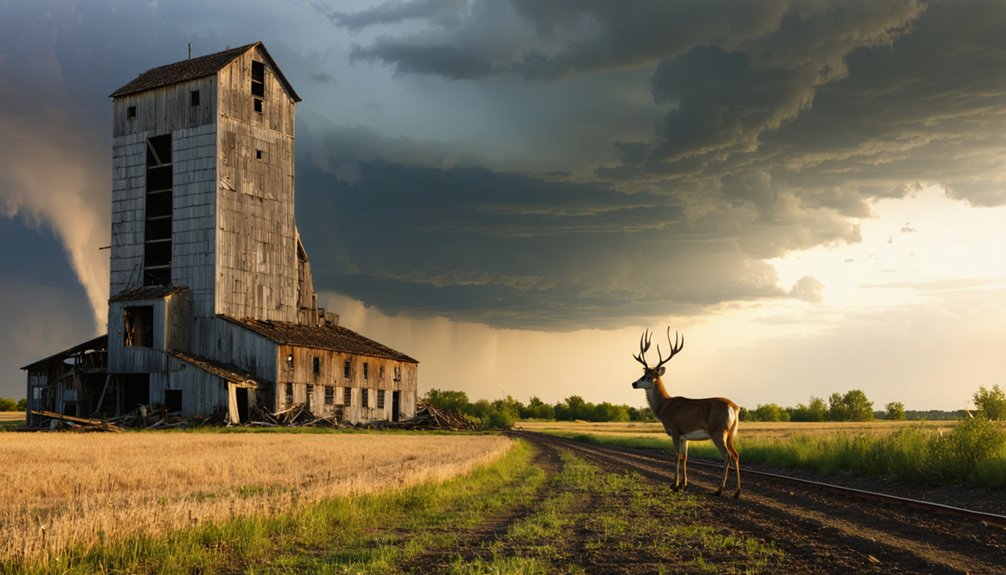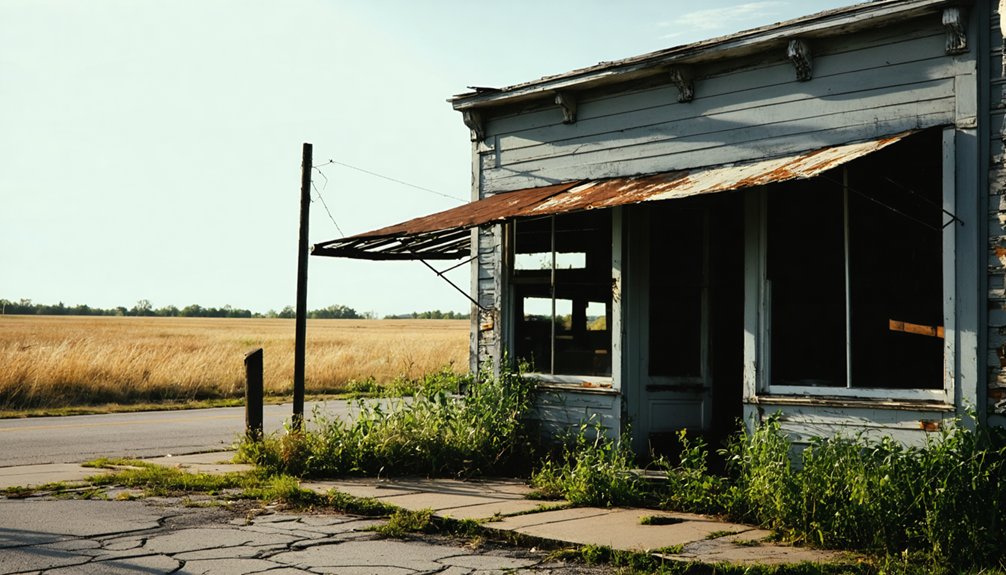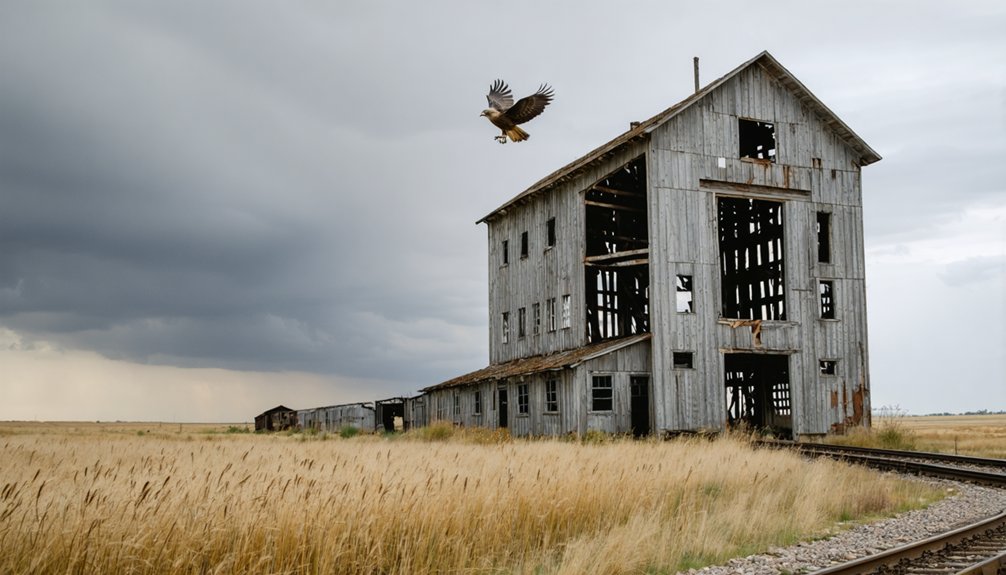You’ll find Manchester’s ghost town remains at 1,608 feet elevation along US-14 in South Dakota, where a historic railroad community once thrived. Founded in 1880 as Fairview, it grew into a bustling agricultural hub after the Chicago & North Western Railroad arrived. The town survived until June 24, 2003, when an F4 tornado with 200+ mph winds leveled all structures, leading to its disincorporation in 2004. Today, only foundations, the town pump, and stories of frontier resilience endure.
Key Takeaways
- Manchester was a thriving railroad town established in 1881 that declined due to economic changes and was officially disincorporated in 2004.
- The town was completely destroyed by an F4 tornado on June 24, 2003, with winds over 200 mph devastating all remaining structures.
- Only foundations, a town pump, and an abandoned street grid remain today, accessible from US-14 at 1,608 feet elevation.
- Manchester’s population dwindled to just 40 residents by 2000 due to railroad closure, farm consolidation, and urban migration.
- A historical marker now documents the ghost town’s story, including its connection to Laura Ingalls Wilder’s sisters and prairie development.
The Birth of a Railroad Town
As the Chicago & North Western Railroad expanded westward into Dakota Territory, Manchester emerged as a promising settlement along its essential transportation route.
Similar to Manchester, England’s rise as the first industrial city by 1835, this Dakota town showed great economic promise through its railway connections.
You’ll find the town’s origins tied to the railroad expansion that transformed this once-quiet area called Fairview into a bustling hub of activity.
The railroad’s arrival sparked rapid town development, bringing necessary services that frontier settlers needed.
The railroad transformed quiet frontier outposts into thriving communities by delivering essential services to pioneering settlers establishing new lives.
You’d have seen grocery stores, a lumber yard, and blacksmith shops spring up to serve both residents and travelers.
The post office’s establishment on June 29, 1881 marked an important milestone in the town’s development.
The growing community soon established key institutions – a town hall, two churches, schools including a high school, and even a local newspaper.
Located just seven miles west of De Smet, Manchester’s strategic position on the rail line made it a significant link in the region’s transportation network.
From Fairview to Manchester: A Name’s Legacy
The transformation from Fairview to Manchester marked a pivotal moment in the town’s early history. When Chester H. Manchester became the first postmaster on June 29, 1881, the town’s name origin shifted from its scenic description to honor his postal legacy. This change reflected the settlement’s evolution from a simple valley outpost to a bustling railroad hub. Similar to how the first industrialized city in England underwent dramatic changes during its development, Manchester, South Dakota experienced its own transformation through the railroad era.
You’ll find three key aspects of Manchester’s naming significance:
- The name change coincided with the establishment of essential postal services
- It represented a broader shift during South Dakota’s railroad expansion era
- The name persisted until the town’s disincorporation in 2004, outlasting the community itself
Today, while only foundations and the town pump remain, the Manchester name continues to symbolize an important chapter in South Dakota’s rural development story.
The Little House Connection
Manchester’s connection to the beloved Little House series runs through Grace Ingalls Dow, youngest sister of author Laura Ingalls Wilder, who made the town her home with husband Nate Dow.
Located just six miles from De Smet, Manchester became an important extension of the Ingalls legacy through Grace’s presence until her death in 1941 at age 64.
You’ll find another fascinating layer to the story through Harvey Dunn, Nathan Dow’s nephew and renowned prairie artist, who captured the essence of the landscape that shaped the Ingalls family saga. The South Dakota Art Museum now showcases his masterful depictions of the region.
Though the devastating F4 tornado of 2003 destroyed the physical town, you can still visit the memorial and historic town pump that mark Grace Dow’s former home.
These remnants continue drawing Little House enthusiasts who seek to experience this meaningful piece of pioneer history.
The town’s destruction made headlines when it was featured on the cover of National Geographic and documented in a Nova special.
Life in Early Manchester
Originally settled as Fairview in eastern Kingsbury County, early Manchester took root along the glacially carved valleys of Redstone Creek when Tom and Bersha Dunn homesteaded the area in 1880.
Life in this prairie community centered around farming and livestock, with residents making the most of the region’s natural resources. Like many other South Dakota towns, Manchester was established as one of the stops located seven miles apart to service steam locomotives.
Community gatherings often revolved around these key elements:
- The town pump served as both a crucial water source and social hub where neighbors connected.
- Farmsteads and homes clustered strategically along waterways, creating natural meeting points.
- Local landmarks, though few in number, became significant anchors for the town’s collective identity.
Without formal governance or a town plat, Manchester’s roughly 40 residents organized themselves around shared rural needs, embodying the independent spirit of South Dakota’s frontier settlements.
Economic Rise and Fall
During its peak between 1880 and 1920, Manchester flourished as an essential agricultural hub along South Dakota’s eastern prairie, where railroad lines connected local farmers to broader markets.
You’d have found a vibrant community with a post office, grocery store, pool halls, and blacksmith shops serving the needs of pioneering families. Like other railroad towns of the era, Manchester boasted two hotels and various merchants to accommodate travelers.
The town’s lack of economic diversification proved fatal when multiple challenges hit. The Great Depression of the 1930s struck first, followed by the devastating Dust Bowl that ravaged crops and livelihoods.
A perfect storm of economic and environmental disasters – the Great Depression and Dust Bowl – devastated Manchester’s agricultural foundation.
Agricultural challenges mounted as younger generations abandoned their family farms for urban opportunities after World War II. The final blow came when the railroad – Manchester’s economic lifeline – ceased operations.
Without alternate industries to sustain it, the town couldn’t recover, joining other South Dakota communities that faded into ghost town status. The town that was once home to Grace Ingalls Dow, sister of Laura Ingalls Wilder, exemplified the pioneering spirit of the northern prairies.
The Town’s Final Years
You’ll find Manchester’s final chapter began quietly, as its population dwindled to just 40 residents by 2000 and basic services vanished from the unincorporated town.
The town pump became the sole surviving structure following the destruction. By 2003, only 103 people remained in 11 buildings, with the town relying entirely on neighboring communities for essential services.
The devastating F4 tornado that struck on June 24, 2003, destroyed every remaining structure, forcing the last residents to relocate and leading to Manchester’s official disincorporation in 2004. The town’s decline had started decades earlier when the rail line deactivated in the 1980s.
Slow Economic Decay
The slow demise of Manchester, South Dakota began in earnest after World War II, when shifting rail demands led to the discontinuation of essential railroad service.
The town’s economic isolation intensified as significant transportation links disappeared, leading to a devastating population decline that would ultimately seal its fate.
Here’s how Manchester’s economy crumbled:
- The loss of railroad access crippled the grain depot operations, eliminating a critical revenue source for local farmers.
- Mechanization and farm consolidation reduced the need for small-town services, forcing businesses to close their doors.
- By 2000, with only 40 residents remaining, the tax base had eroded so severely that basic municipal services became impossible to maintain.
Without rail connections or a sustainable economic base, Manchester couldn’t compete with larger regional centers, accelerating its march toward ghost town status.
Tornado’s Final Blow
On June 24, 2003, a devastating F4 tornado delivered Manchester’s final death blow, packing winds over 200 mph and creating an unprecedented 100 MB pressure drop in just five seconds. The storm was part of “Tornado Tuesday,” when 67 tornadoes ripped through eastern South Dakota, but Manchester bore the worst impact.
While studying tornado dynamics yielded groundbreaking scientific data, the human toll proved irreversible. Despite no deaths, the town’s remaining community resilience crumbled as residents relocated to nearby communities.
By 2004, the South Dakota legislature officially disincorporated Manchester. Today, you’ll find only scattered remnants of the former town, including a monument that commemorates its rich history.
The tornado marked not just the end of Manchester’s physical existence, but the conclusion of its century-long struggle to survive.
Nature’s Last Strike: The 2003 Tornado

If you’d lived in Manchester on June 24, 2003, you’d have witnessed one of South Dakota’s most powerful tornadoes tear through your community with winds up to 260 mph.
The EF4 tornado carved a destructive 10-mile path that leveled every remaining structure in the small town, which had fewer than 50 residents at the time.
This final blow from nature marked Manchester’s ultimate change into a ghost town, leading to its official disincorporation by the South Dakota legislature in 2004.
Devastating F4 Path
During South Dakota’s infamous “Tornado Tuesday” on June 24, 2003, a devastating F4 tornado ripped through Manchester with winds exceeding 200 mph, completely destroying the small town.
The tornado’s destructive path through Manchester revealed unprecedented force that you’d rarely witness in recorded history. Storm chaser Tim Samaras captured groundbreaking measurements that would forever change tornado research, documenting a rapid 100 MB pressure drop – equivalent to instantly ascending 4,000 feet.
Here’s what made this tornado particularly remarkable:
- It destroyed every structure in Manchester, leading to the town’s disincorporation in 2004.
- Despite total destruction, there weren’t any fatalities.
- No tornado warnings were issued for Kingsbury County before impact.
The community’s resilience showed as residents relocated to nearby towns, marking the end of Manchester’s incorporation.
Final Standing Buildings Fall
The devastating F4 tornado released its final blow on Manchester’s remaining structures within a matter of minutes on June 24, 2003, as wind speeds reaching 260 mph systematically dismantled every building in the small South Dakota town.
As the multi-vortex storm moved through, you’d have witnessed the final building collapse unfold in rapid succession. The tornado’s intense pressure drop of around 100 millibars triggered explosive structural failures, while debris-laden winds stripped away roofs and walls.
In the tornado’s aftermath, nothing remained standing – only scattered foundations and rubble marked where buildings once stood. The destruction was so complete that South Dakota’s legislature officially disincorporated Manchester in 2004.
Today, you’ll find only a memorial monument marking the ghost town’s location, surrounded by ruins that serve as stark reminders of nature’s raw power.
What Remains Today
Modern visitors to Manchester, South Dakota will find little more than foundations, a town pump, and an abandoned street grid where a once-thriving railroad community stood.
At 1,608 feet elevation, you’ll encounter a stark reminder of nature’s power following the devastating F4 tornado of June 24, 2003. The current remains paint a haunting picture of what was once a bustling small town.
If you’re planning to explore this ghost town, you’ll discover:
- A historical marker documenting the town’s story and ultimate destruction
- The original street layout, now weathered by prairie winds and seasonal extremes
- Scattered building foundations that hint at Manchester’s former footprint
The site’s easy access from US-14 makes it a compelling stop for those seeking to experience a piece of South Dakota’s transformed landscape.
Historic Significance in South Dakota

Manchester’s historic significance stems from three pivotal elements: its role as a thriving railroad hub, its connection to the famous Ingalls family, and its representation of prairie town development in eastern South Dakota.
You’ll find Manchester’s cultural heritage deeply intertwined with the pioneer spirit of the northern plains. The town served as home to Grace Ingalls Dow and Mary Ingalls, sisters of renowned author Laura Ingalls Wilder, connecting it to the iconic “Little House” series.
As a crucial railroad stop on the Chicago & Northwestern line, Manchester exemplified the classic prairie town experience, complete with essential services that supported regional agricultural commerce.
The town’s eventual decline mirrors the broader pattern of rural transformation in South Dakota, from the challenges of the Dust Bowl through post-World War II urbanization.
Frequently Asked Questions
Are There Any Surviving Photographs of Manchester Before the 2003 Tornado?
You’ll find few documented historic photographs of pre-tornado Manchester, though some may exist in private collections. The 2003 tornado impact destroyed most physical records of this once-thriving railroad town.
Can Visitors Access the Original Town Pump Site Today?
Yes, you’ll find the historic town pump easily accessible from US-14 and 425th Avenue. It’s one of the few authentic pieces of town history remaining after the 2003 tornado’s destruction.
What Happened to the School Where Grace Ingalls Dow Taught?
You won’t find the original school where Grace Ingalls Dow taught, as it’s no longer standing. Like much of Manchester’s Ingalls legacy, the school history faded when the town declined in the early 1900s.
Were Any Artifacts From Manchester Preserved in Local Museums?
You’ll find some Black Hills mining artifacts in local history museums, but there’s no clear record of items specifically labeled as Manchester’s in regional collections or historical societies.
Did Any Original Manchester Families Remain in Nearby Towns?
Like scattered seeds taking root elsewhere, you’ll find original Manchester families did transplant to nearby towns, particularly De Smet and Huron, where their descendants remain today following migrations through the 1930s.
References
- https://kids.kiddle.co/Manchester
- https://www.youtube.com/watch?v=Glucs_Rq8Xs
- https://www.ghosttowns.com/states/sd/manchester.html
- https://www.youtube.com/watch?v=pCEj7SLdwVA
- https://en.wikipedia.org/wiki/List_of_ghost_towns_in_South_Dakota
- https://www.hmdb.org/m.asp?m=162693
- https://www.hmdb.org/m.asp?m=118680
- https://history.sd.gov/docs/MarkersMasterNumerical.pdf
- https://en.wikipedia.org/wiki/Manchester
- https://en.wikipedia.org/wiki/Fairview



